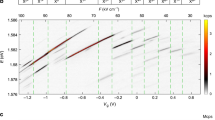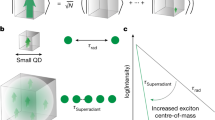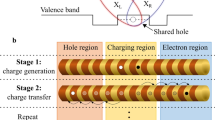Abstract
Self-assembled quantum dots comprise a versatile system with which to study quantum effects in the solid state. Many devices have been developed that demonstrate controlled charging of a quantum dot1, Rabi oscillations2, coherent spin control3 and electrically injected non-classical photon emission4. Often referred to as ‘artificial atoms’, quantum dots have discrete energy levels, making them a viable candidate for encoding qubits. However, unlike single atoms, no two quantum dots are alike. This is a complication for quantum-information applications that require qubits initialized in the same state and interactions between remote systems mediated by indistinguishable photons. We report that truly remote, independent, quantum dots can be tuned to the same energy using large applied electric fields. This allows two-photon interference5 of their emission under coincidence gating and opens up the possibility of transferring quantum information between remote solid-state sources.
This is a preview of subscription content, access via your institution
Access options
Subscribe to this journal
Receive 12 print issues and online access
$209.00 per year
only $17.42 per issue
Buy this article
- Purchase on Springer Link
- Instant access to full article PDF
Prices may be subject to local taxes which are calculated during checkout



Similar content being viewed by others
References
Warburton, R. et al. Optical emission from a charge-tunable quantum ring. Nature 405, 926–929 (2000).
Zrenner, A. et al. Coherent properties of a two-level system based on a quantum-dot photodiode. Nature 418, 612–614 (2002).
Atature, M. et al. Quantum-dot spin-state preparation with near-unity fidelity. Science 312, 551–553 (2006).
Yuan, Z. et al. Electrically driven single-photon source. Science 295, 102–105 (2002).
Hong, C., Ou, Z. & Mandel, L. Measurement of subpicosecond time intervals between two photons by interference. Phys. Rev. Lett. 59, 2044–2046 (1987).
Maunz, P. et al. Quantum interference of photon pairs from two remote trapped atomic ions. Nature Phys. 3, 538–541 (2007).
Olmschenk, S. et al. Quantum teleportation between distant matter qubits. Science 323, 486–489 (2009).
Beugnon, J. et al. Quantum interference between two single photons emitted by independently trapped atoms. Nature 440, 779–782 (2006).
Chanelière, T. et al. Quantum interference of electromagnetic fields from remote quantum memories. Phys. Rev. Lett. 98, 113602 (2007).
Kaltenbaek, R. et al. Experimental interference of independent photons. Phys. Rev. Lett. 96, 240502 (2006).
Halder, M. et al. Entangling independent photons by time measurement. Nature Phys. 3, 692–695 (2007).
Sanaka, K. et al. Indistinguishable photons from independent semiconductor nanostructures. Phys. Rev. Lett. 103, 053601 (2009).
Patel, R. et al. Postselective two-photon interference from a continuous nonclassical stream of photons emitted by a quantum dot. Phys. Rev. Lett. 100, 207405 (2008).
Ates, S. et al. Post-selected indistinguishable photons from the resonance fluorescence of a single quantum dot in a microcavity. Phys. Rev. Lett. 103, 167402 (2009).
Oulton, R. et al. Manipulation of the homogeneous linewidth of an individual In(Ga)As quantum dot. Phys. Rev. B 66, 045313 (2002).
Findeis, F., Baier, M., Beham, E., Zrenner, A. & Abstreiter, G. Photocurrent and photoluminescence of a single self-assembled quantum dot in electric fields. Appl. Phys. Lett. 78, 2958–2960 (2001).
Finley, J. et al. Quantum-confined stark shifts of charged exciton complexes in quantum dots. Phys. Rev. B 70, 201308 (2004).
Berthelot, A. et al. Unconventional motional narrowing in the optical spectrum of a semiconductor quantum dot. Nature Phys. 2, 759–764 (2006).
Santori, C. et al. Indistinguishable photons from a single-photon device. Nature 419, 594–597 (2002).
Bennett, A. et al. Indistinguishable photons from a diode. Appl. Phys. Lett. 92, 193503 (2008).
Legero, T., Wilk, T., Kuhn, A. & Rempe, G. Time-resolved two-photon quantum interference. Appl. Phys. B 77, 797–802 (2004).
Bennett, A., Patel, R., Nicoll, C., Ritchie, D. & Shields, A. Interference of dissimilar photon sources. Nature Phys. 5, 715–717 (2009).
Rarity, J. et al. Two-photon interference in a Mach–Zehnder interferometer. Phys. Rev. Lett. 65, 1348–1351 (1990).
Brendel, J., Gisin, N., Tittel, W. & Zbinden, H. Pulsed energy–time entangled twin-photon source for quantum communication. Phys. Rev. Lett. 82, 2594–2597 (1999).
Franson, J. Bell inequality for position and time. Phys. Rev. Lett. 62, 2205–2208 (1989).
Lettow, R. et al. Quantum interference of tunably indistinguishable photons from remote organic molecules. Phys. Rev. Lett. 104, 123605 (2010).
Flagg, E. et al. Interference of single photons from two separate semiconductor quantum dots. Phys. Rev. Lett. 104, 137401 (2010).
Acknowledgements
This work was partly supported by the European Union through the Information Science Technologies Framework Program 6 Integrated Projects Qubit Applications (QAP, contract no. 015848; Q-ESSENCE, contract no. FP7/2007–2013). EPSRC provided support for R.B.P. and QIPIRC for C.A.N. We would also like to thank D. Granados and R. J. Young for useful discussions.
Author information
Authors and Affiliations
Contributions
I.F., C.A.N. and D.A.R. carried out MBE growth of the samples. R.B.P. fabricated the devices. R.B.P. and A.J.B. performed the experiments and data analysis. R.B.P. wrote the paper with input from A.J.B. and A.J.S. A.J.S. guided the work.
Corresponding author
Ethics declarations
Competing interests
The authors declare no competing financial interests.
Supplementary information
Rights and permissions
About this article
Cite this article
Patel, R., Bennett, A., Farrer, I. et al. Two-photon interference of the emission from electrically tunable remote quantum dots. Nature Photon 4, 632–635 (2010). https://doi.org/10.1038/nphoton.2010.161
Received:
Accepted:
Published:
Issue Date:
DOI: https://doi.org/10.1038/nphoton.2010.161
This article is cited by
-
Quantum interference of identical photons from remote GaAs quantum dots
Nature Nanotechnology (2022)
-
A tuneable telecom wavelength entangled light emitting diode deployed in an installed fibre network
Communications Physics (2020)
-
Low-noise GaAs quantum dots for quantum photonics
Nature Communications (2020)
-
Radiative Auger process in the single-photon limit
Nature Nanotechnology (2020)



